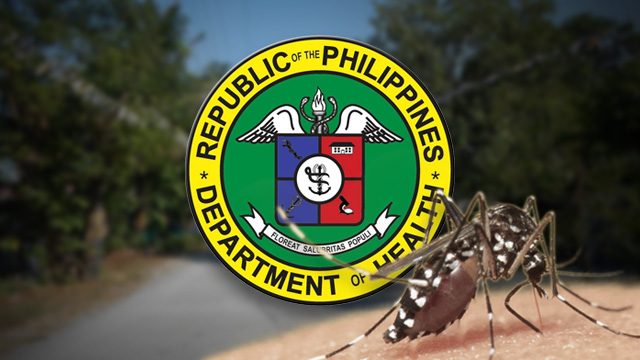SUMMARY
This is AI generated summarization, which may have errors. For context, always refer to the full article.

MANILA, Philippines (UPDATED) – The Department of Health (DOH) on Tuesday, August 16 revealed around 80 barangays (villages) in the country dubbed dengue clusters or “hot zones.”
The number doubled from the 47 hot zones earlier identified by the department.
The following barangays located in 11 regions reported 3 or more dengue cases for the past 4 consecutive weeks:
| REGION | PROVINCE | CITY/MUNICIPALITY | BARANGAY |
I |
Pangasinan |
Asingan | Baro |
Binalonan |
Bugayong | ||
| Santa Catalina | |||
| Dagupan City | Calmay | ||
| Mabini | Poblacion | ||
| Umingan | Prado | ||
III |
Pampanga | Lubao | San Roque Dau |
| Zambales | Olongapo City | Gordon Heights | |
IV-A |
Batangas |
Batangas City | Kumintang Ibaba |
| Lipa City | Bagong Pook, Marauoy | ||
| San Jose | Banaybanay I, Banaybanay II, Lumil, Pinagtung-ulan | ||
| Taysan | Mapulo | ||
Laguna |
Cabuyao | Gulod | |
| San Pablo City | San Lucas 2 | ||
| San Pedro | San Vicente | ||
Rizal |
Angono | Mahabang Parang | |
| Antipolo City | San Jose (Pob.) | ||
| Cainta | San Andres (Pob.) | ||
| Rodriguez | San Isidro | ||
| IV-B | Oriental Mindoro | Calapan City | Parang |
VI |
Antique | San Jose | Funda-dalipe |
| Negros Occidental | Bago City | Calumangan | |
VII |
Cebu |
Barili | Tal-ot |
| Cebu City | Lusaran, Pardo (Pob.) | ||
| Dumanjug | Pawa | ||
| Toledo City | Carmen | ||
| Negros Oriental | Bindoy | Poblacion (Payabon) | |
| VIII | Southern Leyte | Padre Burgos | Santo Rosario |
X |
Bukidnon |
Kibawe | Talahiron, West Kibawe (Pob.) |
Lantapan |
Alanib | ||
| Balila | |||
Malaybalay City |
Simaya | ||
| Sumpong | |||
| Manolo Fortich | Lingion | ||
| Quezon | Salawagan | ||
| Sumilao | Kisolon | ||
Valencia City |
Batangan | ||
| Poblacion | |||
Lanao Del Norte |
Iligan City | Suarez | |
| Lala | Maranding | ||
Misamis Oriental |
Cagayan de Oro City |
Bugo | |
| Bulua | |||
| Cugman | |||
| Iponan | |||
| Kauswagan | |||
XI |
Davao del Norte | Panabo City | San Vicente |
Davao del Sur |
Davao City |
Bucana | |
| Catalunan Pequeño | |||
| Matina Crossing | |||
| Mintal | |||
| Davao Oriental | Mati | Bobon | |
| Central (Pob.) | |||
| Matiao | |||
CAR |
Apayao | Pudtol | Cacalaggan |
Benguet |
Baguio City |
Irisan | |
| Modern Site, West | |||
| Pinsao Pilot Project | |||
| Pinsao Proper | |||
| Sanitary Camp, North | |||
| Buguias | Loo | ||
La Trinidad |
Ambiong | ||
| Bahong | |||
| Balili | |||
| Betag | |||
| Pico | |||
| Poblacion | |||
| Puguis | |||
| Tawang | |||
| Wangal | |||
| Tublay | Caponga (Pob.) | ||
NCR |
Metro Manila |
Pasig City | Pinagbuhatan |
Quezon City |
Batasan Hills | ||
| Fairview | |||
| Holy Spirit | |||
| Pinyahan |
*Source: DOH Epidemiology Bureau
According to Health Spokesperson Eric Tayag, if the cases in these clusters continue to rise, it could indicate a possible dengue outbreak in the barangay, especially if deaths were reported in the area.
Dengue, a disease common in tropical and sub-tropical countries in the world, is transmitted through the bite of an Aedes mosquito, according to the World Health Organization. Dengue fever is potentially fatal and mainly affects children.
Dengue is a common disease during the rainy season. The Philippines is one of 4 countries in the Western Pacific which reported the highest dengue incidence in recent years. (READ: Dengue cases to rise in 2016 due to El Niño – DOH)
The health department reported 70,697 suspected dengue cases from January 1 to July 23, 2016 – 19.1% higher compared to the same period in 2015 (59,342 cases). Of this number, 308 died (0.44% case fatality rate).
Most of the suspected dengue cases were from Calabarzon (11.9%), Central Visayas (9.9%), Soccsksargen (9.2%), Northern Mindanao (9.1%), and Central Luzon (9%).
The DOH also recorded 521 laboratory confirmed dengue cases, most of which were from the Zamboanga Peninsula.
*Source: DOH Epidemiology Bureau
Tayag reminded the public to keep their environment and homes clean to prevent mosquitoes from breeding.
He also urged Filipinos to seek early consultation as soon as they experience the “danger signs” of dengue, which include not only fever but also vomiting and abdominal pain. – Rappler.com
Mosquito sucking blood image from Shutterstock
Add a comment
How does this make you feel?
There are no comments yet. Add your comment to start the conversation.